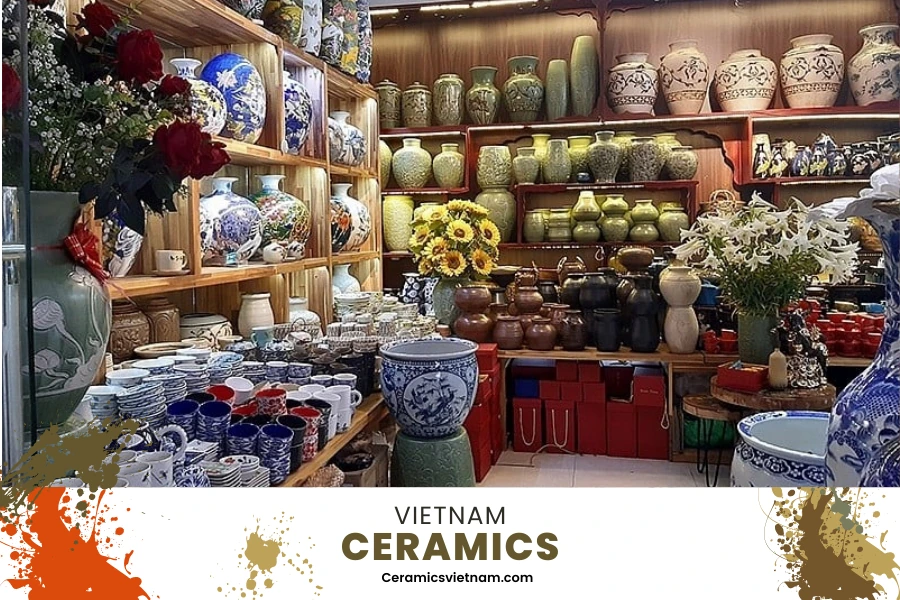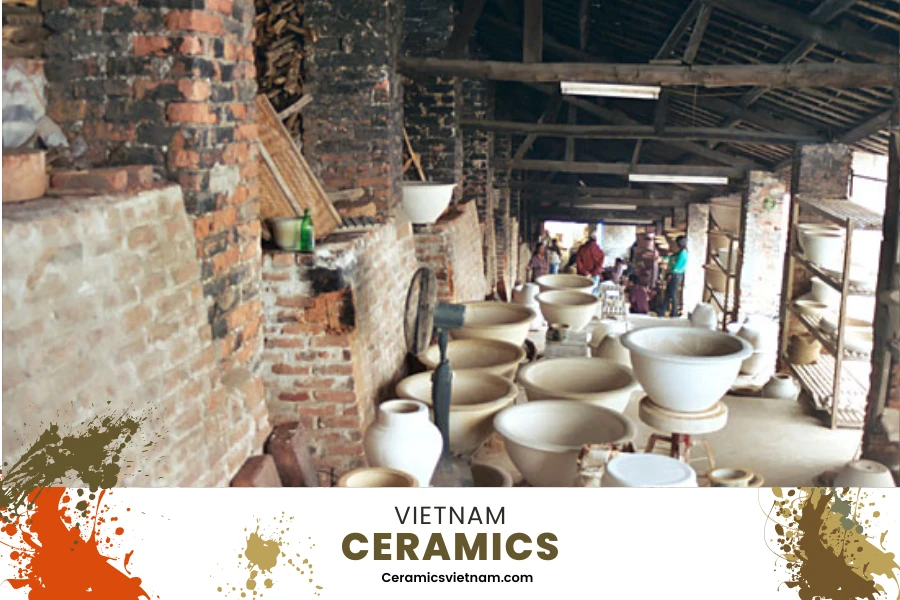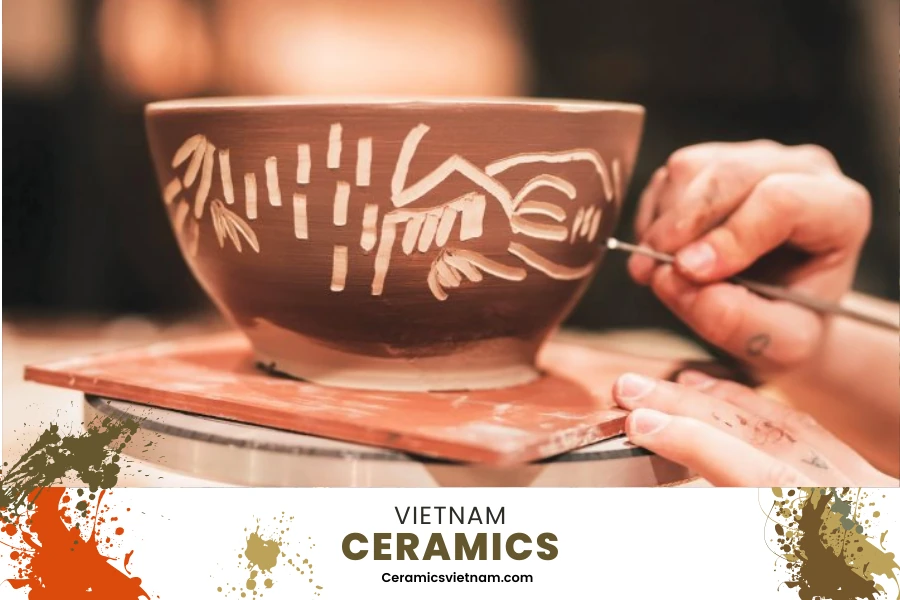Many years ago, visitors to the Bát Tràng pottery village (Gia Lam, Hanoi) used to feel uncomfortable due to the smoke emanating from the pottery kilns. However, in recent years, with relentless efforts, Bat Trang is gradually changing its appearance and becoming a shining model for the development of a ‘green’ craft village.
Introduction to Bat Trang Pottery Village in Hanoi

Bát Tràng transitions from a ‘smoky’ craft village to a ‘green’ craft village
Bat Trang Pottery Village is situated on the left bank of the Red River, now belonging to Bat Trang Commune, Gia Lam District, Hanoi, approximately 10 kilometers southeast of the city center. This traditional craft village is renowned for its ceramic and porcelain products.
The village dates back to the time of the Ly Dynasty. With over 500 years of history marked by numerous ups and downs, the name Bat Trang has persisted and continues to flourish to this day. The pottery products from Bat Trang have been consistently praised for their quality, diverse designs, patterns, and classifications, encompassing various functional groups such as household ceramics, religious artifacts, artistic ceramics, construction ceramics, and decorative ceramics.
Bat Trang pottery products are circulated nationwide and even reach foreign markets. Beyond being a hub for creating a nationally recognized product brand, Bat Trang Pottery Village plays a crucial role in preserving the cultural values of the capital. Additionally, it has become a favored tourist destination in Hanoi.
The village not only contributes to the establishment of a national product brand but also plays a role in preserving the cultural values of the capital city. Bat Trang Pottery Village has become one of the preferred tourist destinations in Hanoi, attracting many visitors
The polluted craft village with dust

Bát Tràng transitions from a ‘smoky’ craft village to a ‘green’ craft village
Bat Trang pottery and porcelain village is a long-standing traditional craft village, renowned for its high-quality ceramic products meeting domestic and international demands. However, during its development, Bat Trang went through a crisis due to environmental pollution affecting the brand, image, and overall quality of the craft village.
In the past, the people of Bat Trang commonly used coal-fired kilns for pottery firing. Each firing batch lasted continuously for 3-5 days, resulting in a substantial release of emissions into the environment. On average, each coal-fired pottery batch produced around 2.5 tons of solid waste.
Additionally, dozens of trucks and modified vehicles transported raw materials daily, contributing to a dusty and polluted atmosphere. Furthermore, the chemicals used in ceramic production to enhance quality, preserve products, create glazes, and paint, directly harmed the air quality in the village.
Moreover, soil dust, coal dust, and waste, along with broken ceramics, were piled up on the roadside, forming muddy, filthy heaps every time it rained.
During that time, to mitigate the impact of dust and smoke, locals resorted to simple measures such as spraying water, wearing masks, and donning hats. However, what was truly needed was an improved production process to minimize pollution—a challenge that every traditional craft village faced.
Tran Duc Tan, a skilled artisan from Bat Trang pottery village, shared that in the past, villagers used traditional kilns like frog kilns, plate kilns, and pot kilns, with wood and coal as fuel; each pottery batch had to be fired continuously for 6-8 days. “Laborers had to work extremely hard in a dusty, sweltering environment. Moreover, at that time, just reaching the beginning of Bat Trang village meant encountering dusty coal, greatly diminishing its aesthetic appeal, accompanied by the intense smell of the kilns,” Tan stated.
Faced with the current state of air, water, and soil pollution, Bat Trang has determinedly implemented solutions to improve the environmental situation.
Transformation through clean technology
In conjunction with expanding production space, ensuring the survival of the craft village involves technological improvements, primarily the enhancement of pottery kiln technology. The most notable advancement is the replacement of box kilns with shuttle kilns (gas kilns).
Currently, nearly 100% of the production facilities in Bat Trang use gas and electric kilns. With this new kiln type, each pottery batch only takes 15-20 hours to fire, applying automation for easy operation and remote temperature control.
“Over 90% of the products from these kilns are of the highest quality, saving 30% in energy consumption per unit of product. Profits have also increased 2-3 times compared to the old technology. Importantly, we have eliminated 100% of solid waste, dust, and reduced labor by 60% in hazardous environments,” said Mr. Ha Van Lam, Head of the People’s Representative Committee of Bat Trang Pottery Village.
According to Ms. Ha Thi Vinh, Vice President of the Vietnam Craft Village Association and President of the Hanoi Craft and Folk Art Association, compared to traditional kilns, building a gas kiln incurs significantly higher costs, but it brings economic efficiency, product quality, reduced labor, time savings, and notably, a significant environmental improvement. “Now, people can breathe and enjoy the fresh air in Bat Trang without worrying about dust and smoke,” Ms. Vinh remarked.
To produce in a cleaner way, based on local practices, Bat Trang craft village has mastered the use of liquefied gas-fired kilns. To save energy and reduce costs, Ms. Ha Thi Vinh believes that it is essential to design new gas kilns, select the right fire-resistant materials, use equipment with the correct technical specifications, and tailor them to the usage needs of the firing product.
In the future, encouraging the use of solar power for drying and electric grid connection, serving electric kilns with temperatures below 1,200 degrees Celsius, is a good condition for the craft village to contribute to replacing liquefied gas energy, reducing production costs, and improving the craft village environment. Policies that incentivize producers to invest in equipment and create new energy sources to ensure a green environment should also be considered.
A day in Bat Trang Pottery Village

Bát Tràng transitions from a ‘smoky’ craft village to a ‘green’ craft village
Embark on a market journey where you’ll encounter numerous pottery families, providing the freedom to interact with any of them. Engaging with the locals offers insightful knowledge about ceramics and the rich history of the village, with the captivating highlight being the mesmerizing process of manual pottery-making by skilled artisans.
Although these families primarily sell ceramic products in bulk rather than retail quantities, fear not, as the bustling Bat Trang market has everything you desire.
The market boasts a vast array of pottery items, neatly organized into various stalls for daily household use, decorative pieces, worship items, and souvenirs. Most products are reasonably priced, and with a Vietnamese companion, you might even score some savings.
The most captivating aspect of visiting the pottery families is the unique service they offer, allowing tourists to try their hand at making pottery. This experience has captured the interest of many, with youngsters and foreign tourists spending an entire day crafting heartfelt gifts. Armed with wet clay, water basin, and turn-table, you can begin your creative journey.
However, pottery-making is no easy task. Some invest up to 5 hours, and one small mistake can ruin the masterpiece. Yet, despite the challenges, it’s an incredibly rewarding experience, offering the freedom to mold clay into anything your heart desires.
Once shaped, your pottery is fired in the kiln for 15-30 minutes. Afterward, indulge your artistic side by painting and decorating. Handcrafted masterpieces range from 30,000 to 100,000 VND, becoming priceless mementos and cherished parts of your Bat Trang experience.
For those not keen on pottery-making, another option is to decorate pre-made pottery. Choose from a variety of pre-crafted pieces and personalize them. Adorned items are available at reasonable prices, ranging from 30,000 to 50,000 VND.
Essential tips for exploring the Bat Trang market:
- Bargain Smartly: Haggling is common, so negotiate for the best deal.
- Inspect Product Quality: Check drawing lines, colors, and overall condition before purchasing.
- Walk with Care: Be mindful of surroundings to avoid damaging fragile items.
- Plan Your Shopping: Leave shopping until the end of your trip to explore without worries.
After a fulfilling day, visit the Bat Trang Pottery Museum to deepen your understanding of this ancient craft. The museum showcases a fascinating collection of historical and cultural artifacts, offering a glimpse into Bat Trang’s rich heritage.
The museum displays intricately crafted pottery, highlighting the evolution of techniques over centuries. Another highlight is capturing memorable moments with a photo session at the village, surrounded by picturesque scenery, traditional houses, and stunning pottery.
As your day concludes, savor the magic of the village. The memories of interactions, hands-on experiences, and delightful flavors will stay with you. Whether a seasoned traveler or first-time visitor, Bat Trang Pottery Village promises an enchanting encounter with art, culture, and heritage that leaves an indelible mark on your heart.














Leave a reply